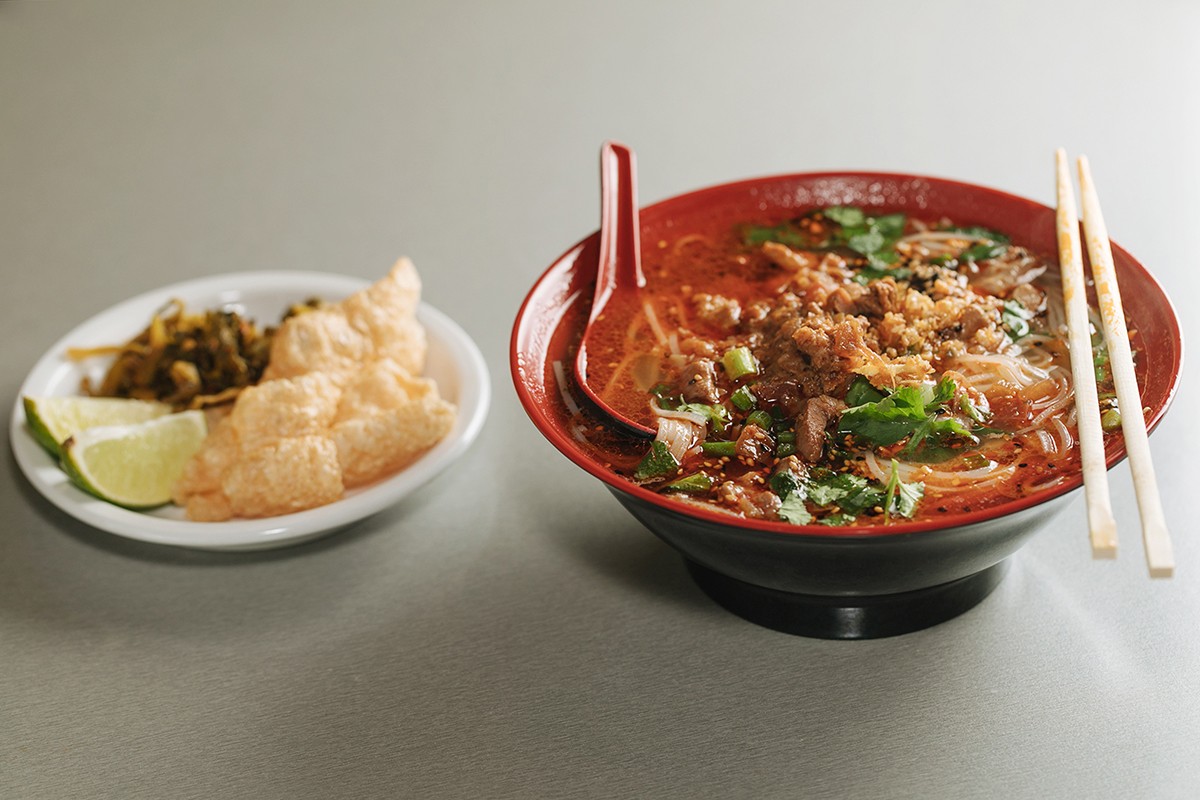While Oakland’s gentrifying face lift sometimes feels like a monocultural invasion of restaurants tricked out in reclaimed wood and mid-century modern furniture, Downtown Berkeley’s renovations have made room for all types. A Taiwanese bakery, a poke joint, a “fourth-wave” coffee spot, and artisanal boba all coexist in close quarters. The neighborhood hasn’t sacrificed its character, its crust punks, or its affordable, delicious, multinational eats.
Tharaphu Burmese Street Food fits right in. Its bowls of authentically Burmese soups, noodles, curries, and snacks are all under ten dollars, making it easy for people to eat their way through the menu’s sophisticated mix of Indian, Lao, Thai, and Chinese influences.
The place used to be a tea and dessert shop called Bobo Drinks, until owners Nora Aung and Mindy Oong converted it to a Burmese spot last fall. Aung always intended for the spot to be Burmese. It was a dream of hers since she was a teenager growing up in Mandalay. But she said that launching the tea shop gave her the small-business experience she needed before she could start serving the food she craved from Mandalay and Yangon — dishes that are unapologetically pungent and are perfumed with spices and fresh onion, ginger, garlic, and cilantro.
The restaurant attracts demanding and adventurous food lovers. During one visit, I watched a businessman give his lunchmates a tour of the menu like a docent at a museum. Down the way, a younger man eating alone asked the server if the chicken curry was made with dark meat: “If it’s not dark, I’ll have the pork then.”
The chicken curry is a good, appealing choice on a menu filled with tempting dishes. It was rich with coconut and deeply flavorful. But for me the real draw was Tharaphu’s soup and noodle menu, especially with winter setting in. My bowl of coconut noodle soup was a forward assault on the pores and sinuses. It fought back the cold and made me lose all awareness of any other diners. The soup’s surface shone with the fragrant oil that emerges when coconut milk is long-cooked. A prod of the chopsticks revealed a thick, umami-rich broth in which the chicken’s tenderness made room for both the firm chew of perfectly cooked noodles and the twiggy snap of fried noodles. The coconut milk softened the pain and splendor of the broth’s chili and spice. I drained that bowl wide-awake, clear headed, and sated.
The soups cry out to be eaten as fast as possible, but it’s hard not to go slow to enjoy them. This was particularly evident with the Shan noodle soup, which included chicken, tomatoes, peanuts, and fried garlic, all showered in toasted sesame seeds and accompanied by fried pork rinds and house-made pickles. It was like eating a rhapsody. How can one not linger over a fried pork rind, dipping it carefully into the broth to listen to it pop like Rice Krispies? I alternated between bites of pickle and sesame-seed-laden noodles — all the better to set off the nuttiness of the sesame. Upon first sip, the star anise-scented broth was clear and clean. After giving it time, though, it became a thicker slurry as the ingredients melded together.
Fritters are meant for dipping into and eating alongside both of these soups. I found the opa (a kind of squash) fritter not quite to my liking — the squash’s taste and texture revealed it to be a closer relative to cucumber than to other squash. I found the warmer, heartier samusas and the yellow chickpea-tofu — silky as pudding on the inside — to be my favorites.
These recipes are ones that Aung cooks for her family, and many of them taste like that — straightforward, unusually delicious, and soothing to a hungry soul. The Burmese fried rice was arranged in a wide dish, yellow with turmeric and scrambled eggs. It glowed like a sun. Unlike many fried-rice dishes, the eggs were softly scrambled to form large, fluffy curds, as opposed to the usual method of frying them hard and folding them briskly into the rice. The fried rice was dotted with chewy, spiced chickpeas and was aromatic with ginger, crisp slices of white onion, and fried shallot and garlic. I could easily eat this for breakfast, especially with a strong cup of Burmese milk tea — similar to Thai tea, but strong enough to make you feel like your heart has been thrown off rhythm.
There were certainly a few misses. Mostly, I found the salads lacking. The rainbow salad paled in comparison to Burma Superstar’s more abundant version, which has four kinds of noodles that get mixed together tableside. The tea-leaf salad lacked the dynamism of Burma Bear’s. The tofu nwe, a chickpea-tofu porridge with rice noodles that was topped with soy sauce and fried garlic, was another well-prepared, beautiful breakfast option. However, it was a touch bland — not to my taste, but perhaps more appealing to others who love congee. There were also times when I wanted just a touch more heat, as was the case with the Shan noodle soup. There aren’t any tableside chilies to add, though you can order things spicier at the outset.
Service is helpful and attentive, though sometimes rushed. Most nights, a single server flies solo, navigating the waves of customers in Tharaphu’s small dining room as business rises and falls, with only a little bit of support from the kitchen staff.
Still, this is the kind of spot where the servers will remember you. That’s part of what makes Downtown Berkeley not just a more fun and varied neighborhood, but also a warmer place to be.















